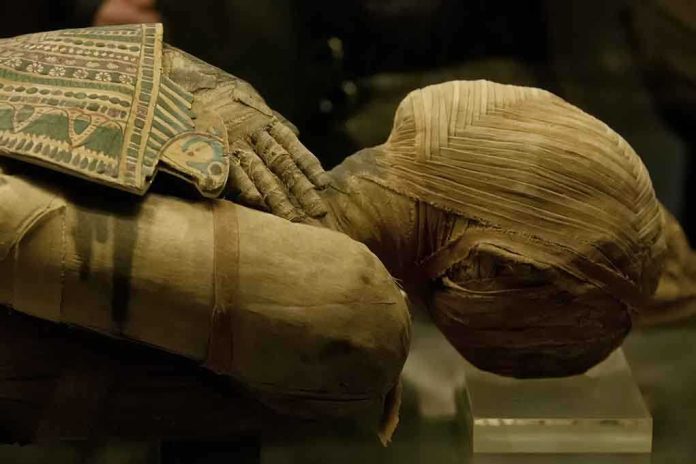
One hundred years after its glorious unveiling, Tutankhamun’s tomb now teeters on the edge of collapse, threatening to erase both its dazzling treasures and the secrets of Egypt’s most enigmatic boy king before the world can intervene.
Story Snapshot
- Tutankhamun’s tomb faces its greatest structural threat since discovery, with major fractures and water infiltration accelerating decay.
- Experts warn the tomb and its wall paintings could be irreparably lost without immediate, large-scale intervention.
- The crisis highlights deep flaws in heritage management and the broader vulnerability of Egypt’s ancient monuments.
- Scientific consensus underscores both geological and human-driven risks, sparking global calls for action.
Tutankhamun’s Tomb: Ancient Wonder at Imminent Risk
Howard Carter’s iconic discovery of Tutankhamun’s tomb in 1922 transformed Egyptology, revealing treasures unseen for millennia. Now, KV62 stands in stark contrast to its former glory. The tomb’s ceiling is marred by a major fracture, with secondary cracks rapidly multiplying. Water infiltrates through these fissures, creating humidity levels ideal for fungal contamination. Wall paintings—once radiant with color—are fading, flaking, and crumbling. Scientific teams from Cairo University have confirmed the tomb’s fragile Esna shale foundation, warning that the structure is now in its most precarious condition since its unsealing.
The 1994 Valley of the Kings flood marked a catastrophic turning point. Water and sediment seeped into the tomb, raising humidity and fostering fungal growth. This event set in motion decades of deterioration, as environmental and human pressures compounded the tomb’s inherent vulnerabilities. Despite repeated warnings from Egypt’s leading archaeologists and conservationists, preventive action has lagged far behind the escalating threat. The tomb’s small size and location beneath fissured rock make it exceptionally vulnerable, and the Valley’s history of flash floods and geological instability only add to the risk. Each new scientific assessment echoes the previous: the window for effective intervention is closing fast.
Stakeholders and Power Dynamics: Who Can Save KV62?
The Egyptian Ministry of Antiquities holds executive authority over site management but faces mounting criticism for reactive, rather than preventive, approaches. Cairo University’s Faculty of Archaeology, led by professors Sayed Hemeda and Mohamed Atia Hawash, has provided rigorous risk assessments and called for immediate measures. The Egyptian Archaeologists’ Union, represented by Emad Mahdi, demands the formation of a high-level expert committee and continuous monitoring to stave off disaster. UNESCO, as gatekeeper of World Heritage status, exerts international pressure but lacks enforcement power. This tangled web of academics, bureaucrats, and international organizations has so far failed to produce a comprehensive risk management plan, leaving the fate of Tutankhamun’s tomb in limbo.
Power dynamics complicate the crisis. Academics and archaeologists may possess deep expertise, but they lack the authority to implement sweeping changes. Government officials, while holding the reins, too often respond with piecemeal measures or public relations gestures. The international community, watching from afar, can only urge action and hope that the Egyptian authorities will heed the warnings before irreversible loss occurs. Without consensus and urgency from all parties, the tomb’s future remains perilously uncertain.
Structural Collapse: The Science and the Stakes
Recent studies published in Nature’s npj Heritage Science have elevated the alarm. The tomb’s compromised foundation and ceiling fractures are now visible to the naked eye; humidity levels inside the burial chamber are off the charts, and fungal colonies proliferate across painted plaster. Experts predict that even a minor seismic event or another flood could trigger total collapse, obliterating priceless archaeological data and wall art. Calls for practical solutions—regulating humidity, reinforcing the superstructure, and installing real-time monitoring systems—have so far gone unheeded by authorities. Peer-reviewed science and consensus among Egypt’s top archaeologists leave little room for doubt: the time for half-measures has passed.
The implications extend far beyond the walls of KV62. The crisis serves as a grim warning for the entire Valley of the Kings, where Queen Hatshepsut’s mortuary temple and other tombs face similar threats. If Tutankhamun’s tomb collapses, the blow to Egypt’s heritage and tourism industry would be catastrophic. Local communities reliant on tourism revenue would suffer, Egypt’s reputation for heritage stewardship would take a hit, and future generations might never see the wonders that once dazzled the world. The situation demands not just technical fixes but a fundamental shift in how Egypt manages its ancient sites, prioritizing proactive preservation over reactive restoration.
Expert Consensus and Calls to Action
Leading experts agree on the severity of the threat and the urgency of intervention. Professor Sayed Hemeda stresses the necessity of humidity regulation and structural reinforcement, while Professor Mohamed Atia Hawash points to the Valley’s broader geological instability and criticizes the lack of preventive culture in site management. Emad Mahdi advocates for an immediate expert committee and continuous risk monitoring. Peer-reviewed studies and international news outlets support these calls, with no significant contradictions across sources. The chorus of warnings grows louder each month, but meaningful action remains elusive.
The world stands at a crossroads: will Tutankhamun’s tomb become a cautionary tale of lost heritage, or will decisive action preserve its secrets for future generations? The next chapter depends on the choices made now—by those entrusted with Egypt’s treasures, and by those who hold them to account.
Sources:
The Independent (news and expert interviews)
Ancient Origins (background context)
GB News (recent developments and expert commentary)
The Independent (updates and analysis)






